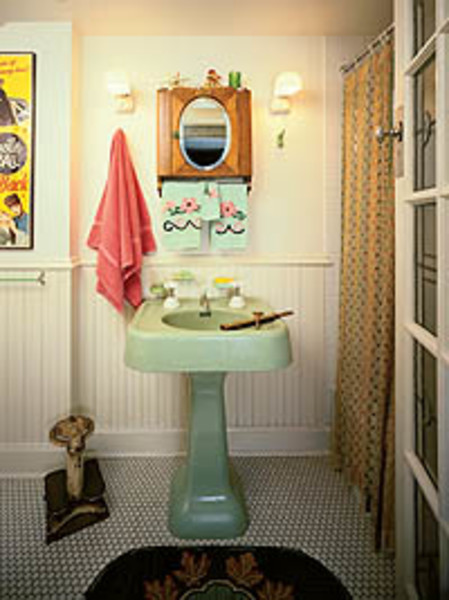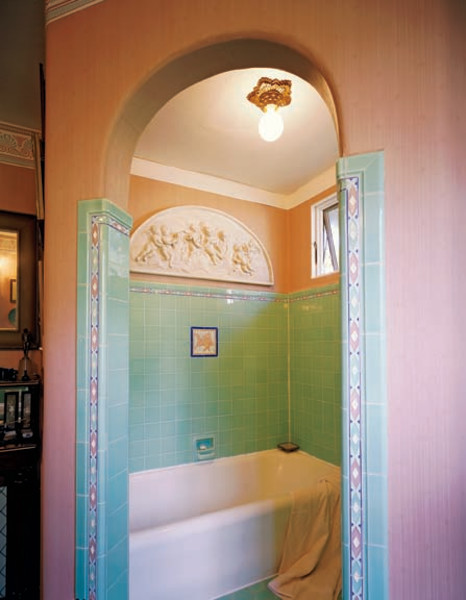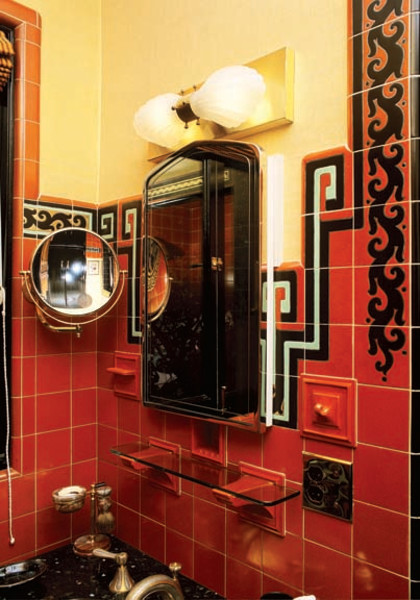
Lights flanking a mirror cut down on harsh shadows and offered optimum illumination for grooming. The shades here—called turtles because of their resemblance to the critter—could also be mounted facing the wall, and often sat on brackets made of porcelain that featured convenient, built-in electrical outlets. (Photo from Bungalow Details: Interior)
If you’re aiming to beautify a bathroom from the era between the wars, your first stop might be Paris—the 1925 Paris Exposition, that is. That famed exposition introduced Art Deco to the world through a wealth of cutting-edge modernist designs, and it was also the source of the name. Within a few years, Deco crossed the Atlantic to become the design imprimatur for American consumer goods throughout the 1930s. Its influence can be seen in creations as disparate as storefronts and theaters, furniture and packaging, and even such basic household fixtures as bathroom sinks and lights. And if what you specifically seek are lights, you’re in luck. What follows are a half-dozen authentic lighting styles appropriate for 1930s bathrooms, almost all of them available through today’s reproduction lighting companies.
Art Deco was considered revolutionary because it turned its back on the vegetable and animal motifs found in traditional designs to embrace angular geometry and the machine age. The style grew out of two popular early 20th-century avant-garde movements: Cubist art and Bauhaus architecture, both of which were defined by sheer, faceted surfaces. When this ultra-modern thinking made the leap from art canvasses and buildings to furniture and industrial items, those angular lines softened to create the distinctive flowing geometric forms that became iconic of the 1930s. Deco’s exuberant take on design also came to embody a sense of optimism, something desperately needed by an American public stuck in a downtrodden decade.
Ceiling Lights
The basic light for any bathroom in the early electric era was a central, ceiling-mounted fixture, and round ceiling fixtures throwing off bright overhead light were a common sight by the 1930s. Lights designed in repeating circle shapes, with cut motifs of decorative ribs, catered to the decade’s fascination with geometric shapes, and their ceiling-hugging designs kept them unobtrusive and aerodynamic. Shades could be made of both clear glass and milk glass, and the mounting was usually a shiny chrome, or in the case of the old advertisement shown on page 36, genuine chromium plate.

The popular idea of putting showers or tubs into their own alcove made it necessary to install a second ceiling light in those areas.
Another ceiling option was a simple globe set into an Art Deco-influenced base bearing a heavy, repeating geometric pattern full of the chevrons and sunrise themes so closely connected with the style. While the base was ornate, the light was also understated thanks to low-profile dimensions and a pairing with a simple milk glass globe. Original bases were most likely made of brass or chrome, but modern lighting companies offer these light fixtures in a range of finishes, as well as a selection of globes that feature additional geometric details, such as concentric circles ridged into the glass or repeating raised squares.
By the 1930s, the prosaic built-in tub was often elaborated into a high-style, partially enclosed niche or recessed shower compartment. Because these compartments created a cavelike environment and frequently had a lower ceiling than the rest of the bathroom, they called for their own ceiling light. Sometimes these lights were regular ceiling fixtures, but they could also incorporate a heat lamp for sun-ray comfort.
Sidelights
Improved task lighting in bathrooms was of growing interest during the Deco era, and the prime focus was the lavatory mirror used for shaving and make-up. The recommended solution for a shadowless reflection was to mount matching fixtures at either side of the mirror. The iconic Deco-era example is the streamlined tube, which reflected the nation’s growing fascination with speed fueled by the early days of commercial passenger flight and the popularity of rail travel.
Streamline styling is related to Deco, but inspired by aerodynamic engineering, it stripped down ornamentation, played up fluid lines, and highlighted industrial materials such as shiny chrome accents. Sometimes polished aluminum, a material borrowed from the nascent airline industry, was used. While streamlined tubes were often enclosed to offer a diffused glow, they also could be open at the top to provide stronger ambient light. Various styles could have accents of concentric bands of chrome and sport elongated, decorative metal finials.

Fixtures installed above a mirror cast a spotlight on the person looking into it. Often, such mirror lights were the only source of illumination in bathrooms from the era.
Another memorable sidelight design paid homage to the burgeoning skylines of the day with shades shaped like a building reaching for the sky. Molded of frosted glass and bearing a shade that was completely enclosed, these fixtures radiated a soft glow. The shades were usually three-tiered, often bearing vertical striations on each section—a form that mimics the famous Deco design of the Empire State Building. Original lights were mounted on porcelain brackets and sometimes color-matched to a bathroom’s tile work. Porcelain was considered particularly appropriate for use in bathrooms because it was non-porous, easy to clean, and therefore sanitary. Sometimes the brackets also harbored electrical outlets for plugging in the wide array of grooming appliances that were just being marketed.
Fan shades were another shape popular for sidelight designs because they exaggerated the chevron pattern so integral to the Deco movement. Often, the fans repeated themselves like ripples formed in water by a skipping stone. Because fans were open at the top and sometimes the bottom, too, they offered the benefits of indirect light via a beam that bounced off of the walls and then onto the person in front of the mirror.
Mirror Lights
Where sidelights were impractical, a single fixture over the mirror became the next best thing for illuminating personal grooming. One popular design was the organic shape of a turtle’s shell morphed into a stylized, softly angular, geometric form that was open on the bottom (where the turtle was flat). This design afforded bathers a direct light just above the mirror. Shades were usually made of milk glass and sometimes had black or colored lines decorating their edges. Turtle shades were incredibly popular owing to their versatility. Because they could be installed horizontally with their opening facing the floor or vertically to face the wall, they could also be used as sidelights. This flexibility gave homeowners several decorative options for lighting bathing areas.
A close relative, design-wise, to the turtle shape was a shell-shaped shade that moved way beyond Mother Nature. These shades exaggerated and softened a shell’s edges to play on the ideas of streamlining, and the fixtures could be installed above a mirror as either a single light or pair.







